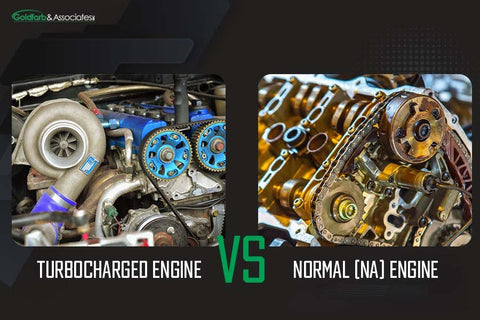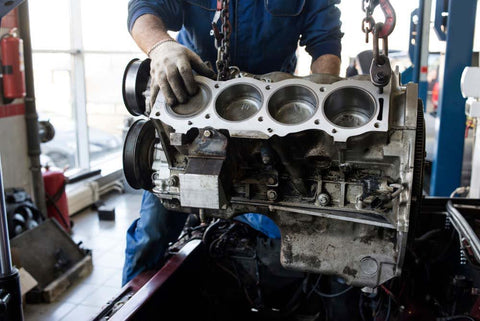The overall car performance varies according to your engine. You will have a different experience with a turbocharged and normal engine. While both engines do the same performance, they come with different features. To get a better engine, you should compare turbocharged engine vs normal engine features to the last detail.
In this article, we will explore both engines' reliability, fuel consumption, noisiness, and horsepower to denote the main difference between a turbo engine and a normal engine. By the end of the article, you will have a clearer picture of both engines.

The Main Difference Between Turbocharged Engine and Normal Engine
Turbocharged engines are often perceived as the upgrade of normal engines because they offer optimized driving conditions. On the other hand, normal engines consume less fuel and offer normal conditions.
So, there’s not a single definitive difference between the engines. To understand turbo vs non-turbo engine life, you should explore the performance from different perspectives, as we explained below.
Turbo engine vs normal engine reliability
Turbo engines utilize pre-used gasses in the engine. This strains the turbo engine more by increasing the pressure on it. You can expect more maintenance and service checkups as a result.
Unlike turbocharged engines, naturally aspirated (NA) engines allow fresh, clean air to enter the engine. Fresh air doesn’t stress the engine, and you can postpone a few service checkups compared to the turbocharges. Also, NA engines are more durable compared to turbocharged engines and, therefore, more reliable.
Turbo engine vs normal engine fuel consumption
One of the main differences between a turbocharged engine and a naturally aspirated one is fuel consumption. Compared to the NA engines, turbocharged engines allow you to speed up faster with no preparation time as they create higher horsepower, which requires more fuel for that cause. So, the turbocharged engine consumes more fuel.
Besides speeding up faster with a turbo engine, you can create more torque, which is ideal for rough paths. This allows you more comfort and security if you live in areas with many uneven paths.
Generally, turbocharged engines are more expensive than the NA engines. But you should keep an eye on sales and promotions so that you can find some affordable turbochargers for sale.
On the other hand, the NA engine consumes less fuel than the turbocharged one as you use the given performance of the engine. It consumes less fuel compared to the turbo engine and saves you money.

Source: shutterstock.com / Photo Contributors: Jackfoto
Turbocharged engine vs normal engine sound
Turbocharged and NA engines sound different because of the air intake and exhaust. NA engines take fresh air through the intake manifold while the stroke of the engine’s intake. This air intake method produces raw sounds or pure sounds unforced by induction.
In contrast, the turbocharged engine uses pre-used gasses, and they force more air into the combustion chamber. This air intake method muffles the sound and creates a rather filtered or seamless sound through the exhaust.
Interestingly, many of you prefer the sound of the NA engine over the turbocharged engine. It’s more tangible and intuitive to hear the raw sound instead of a muffled sound.
Other important factors might also influence the sound. For example, the type of exhaust system, the cylinder arrangement, and the engine produce the sound.
Turbocharged engine vs normal engine horsepower
As mentioned, the turbocharged engine creates more horsepower than the NA engine. They are upgraded NA engines. You will need a larger NA engine and a smaller turbocharged engine to compare the horsepower of a turbocharged engine and an NA engine.
To reach a similar horsepower to a turbocharged engine you will need 1.5x displacement of the NA engine. In other words, a 2.0-liter NA engine has around 150-180 horsepower, while a turbocharged 2.0-liter engine will have 400 horsepower. The difference is more evident in practice.
How to Choose the Better Option
Lifestyle and durability are additional factors to consider when deciding between a turbocharged or NA engine. You should opt for the one that suits your needs.
The turbocharged option is more recommended for those who use their car on long roads, in uphills, or in rough patches. The turbocharged engine allows acceleration, more power, and greater vehicle control.
The normal engine is more recommended for city life. If you use your car in a city with high traffic density, the turbocharged engine will not be an economical or useful addition to your engine. You won't make good use of it.
Furthermore, you should know that the turbocharged engine significantly reduces the engine's life. The increased force on the thermal cycling stress wears off the engine faster than the normal engine. Generally, you can drive 300,000 miles with a turbocharged engine and 450,000 without an NA engine.
Ultimately, the final tip to help you decide and pick the right engine for your needs is to write down why you need a new engine. Evaluate your responses and choose the engine that aligns with your needs. This always helps make the right choice instead of falling for another marketing trick.

Source: shutterstock.com / Photo Contributors: socrates471
Conclusion
Many people have divided opinions regarding the turbocharged engine vs normal engine debate for a good reason. Both have excellent features and offer quality performance.
The turbocharged engine uses more fuel to increase acceleration, horsepower, and improved torque. The NA engine, on the other hand, is more eco-friendly, has a larger lifespan, and produces more satisfying engine sounds.
However, the final word of this engine battle on the better option is yours. Make sure to choose the engine that suits your needs better. This ensures good use of the engine.
You can always consult an expert for a better option. We offer various brands of turbocharged or normal engines ready for sale. You can contact our expert sales team for a recommendation, and they will help you decide.



